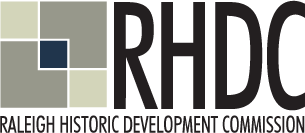The mission of the Raleigh Historic Development Commission is to identify, preserve, protect, and promote Raleigh’s historic resources.
Our Mission
Researching Historic Properties
There are a few local resources that you can use to research the history of a building in Raleigh.
Much of our city's history is documented in the State Archives, located at 109 E. Jones St. You will find old city directories there, as well as Sanborn Fire Insurance maps. To get started, make an appointment with staff at the State Historic Preservation Office .
.
City directories provide occupancy information and the livelihood of the primary occupants. Directories also indicate the absence of a structure, so a series of blank years followed by a listing for an occupant and a description of a building that matches the time-frame may provide an approximate date of construction. Note that in city directories is the street numbering system may change.
Sanborn Fire Insurance maps provide footprint and construction material information about a structure. Comparing the property across various time periods can illustrate the evolution of a property, from original construction through additions and changes. The State Archives has a collection of Sanborn Maps, and some are available online through the Carolina Collection at UNC-Chapel Hill. Refer to the Index or Key Sheet in order to determine which Sheet number contains the building location. Please note that although Sanborn conducted updates annually, all years are not yet available digitally.
The State Archives also has a sizable collection of Raleigh photographs, indexed under keywords. The chances are slim that they have a photo of a specific house since the collection focuses on Raleigh's primary commercial areas, but a search by street name (e.g.: "Blount Street") may yield fruit. For commercial buildings, search business names, street names, etc. Even topics like "parades" or "streetcars" may produce an image of the building in question in the background.
The Archives also houses the private papers of J. Bailey Robeson, who was employed by a Raleigh real estate and insurance company in the early 20th century. These papers include many photos of Raleigh houses taken in the 1920s, when Mr. Bailey's company photographed the houses immediately after construction for insurance purposes. The 8x10 photos are filed by street name, except for one folder of photos that have not yet been identified.
A title search at the Wake County Register of Deeds ![]() will provide the history of a property's ownership. Knowledge of ownership allows a search through probate records for wills, which may include lists of property and heirs. Previous owners or their descendents may have family papers or pictures–family papers are often a gold mine.
will provide the history of a property's ownership. Knowledge of ownership allows a search through probate records for wills, which may include lists of property and heirs. Previous owners or their descendents may have family papers or pictures–family papers are often a gold mine.
Physical evidence of the building can be read by professionals, which may determine the evolution of a property's changes and help establish general dates of changes based upon the construction details observed.
It is usually the analysis of a variety of tidbits from various sources that builds the picture of the history of a property.
If you are researching a historic property, you may wish to utilize the following resources:
- Library of Congress: HABS/HAER/HALS

- NCSU Libraries: NC Architects and Builders

- NCSU Libraries: The Architectural and Building Records of North Carolina

- NCSU Libraries: The Built Heritage of North Carolina

- North Carolina Maps

- North Carolina State Archives

- City of Raleigh Museum

- UNC University Libraries: North Carolina Collection Photographic Archives

- Wake County Register of Deeds

Raleigh Historic Cemeteries
- Historic Oakwood Cemetery and Mausoleum

- Raleigh City Cemeteries Preservation

- Raleigh National Cemetery

Genealogy
If you are searching for genealogical information, please contact the State Library of North Carolina. 
For Your Information
Research Your House
- The National Trust for Historic Preservation provides basic information on how to research your house's history, additional research methods, and looking for physical clues to your house's history.

- Oakwood homeowners Steve Hess and Hope Rollins share their experience researching their house's history.

